9 Assessment and Evaluation
Importance of Assessment and Evaluation Tools
Assessment involves gathering data on learners and their learning processes, providing structured insights into student performance (Baker et al., 2016). This allows instructors to offer timely feedback and targeted support, enhancing student progress. Evaluation tools measure the attainment of learning outcomes, fostering motivation and engagement through self-assessment and reflection. Properly designed peer assessments build community by encouraging collaboration. Understanding assessments is crucial for improving educational practices, supporting curricular planning, and ensuring quality. Well-designed assessments guide learning, maintain academic integrity, and help adapt teaching strategies to meet diverse student needs.
Valid, Reliable, and Fair Assessments
Assessment should be valid, reliable, and fair to ensure clarity and students’ understanding of assessment criteria and assignments.
Validity ensures that assessments accurately measure what they intend to measure, providing students with clear expectations and outcomes.
Reliability ensures consistency in assessment outcomes, enhancing students’ confidence in the fairness and accuracy of their grades.
Fairness ensures that all students have an equal opportunity to demonstrate their knowledge and skills, promoting equity and inclusivity in the learning process.
They also effectively measure the attainment of intended learning outcomes, allowing instructors to assess students’ progress and adjust instruction accordingly. Assessments should be appropriate to students’ profiles, levels, and modes of study while accommodating students’ diverse needs and abilities. Consistency and rigour in marking uphold the integrity of assessments, ensuring that grading standards are applied uniformly and fairly across all students.
Alignment with Learning Outcomes
Aligning assessments with learning and course outcomes is vital for ensuring that students understand what is expected of them and can effectively demonstrate their knowledge and skills. When assessments are closely tied to learning outcomes, students have a clear understanding of what they need to achieve and can focus their efforts accordingly. Aligned assessments provide educators with valuable feedback on student progress and understanding, enabling them to adjust their teaching strategies as needed to better support student learning.
By promoting consistency, relevance, and authenticity in the assessment process, alignment helps ensure that students are being evaluated fairly and accurately on the content and skills they are expected to learn. Alignment also enhances accountability by holding both students and educators responsible for meeting the established learning goals.
Constructive Alignment
The figure below shows this as a bridge with a student preparing to walk across it. For the learner to successfully cross the bridge from the start of the course until the use what the learn in the course, there needs to be alignment.
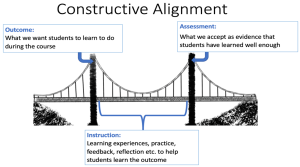
Access further information on What is Constructive Alignment?
Understanding Assessment Principles
At the University of Saskatchewan, assessment principles are essential for evaluating student performance effectively. When designing assessments, it’s imperative to adhere to the following assessment principles.
USask Principles of Assessment
1. Is aligned with learning outcomes and instructional strategies (assessment of learning).
2. Is inclusive and transparent, so students have equitable opportunities to demonstrate their learning.
3. Gives students multiple opportunities to learn through practice and feedback, so they have sufficient time and support to reflect and improve (assessment for learning).
4. Develops student’s ability to learn effectively and prepares students to be self-directed, reflective, and engaged learners (assessment as learning).
5. Is designed so students apply disciplinary learning under authentic, or as close to authentic as possible, circumstances.
6. Is designed and sequenced to optimize students’ success.
7. Provides a valid and trustworthy representation of student achievement that students, educators, disciplines, accrediting bodies, and employers can have confidence in.
8. Is manageable and sustainable for educators, and appropriately facilitated by policy and resourcing.
9. Provides useful information for ongoing course and program enhancement.
10. Forms an integral part of program design, aligning with what programs of study are aiming to achieve within disciplinary communities.
From: TLARC Assessment Review
Types of Assessment
Formative Assessment
Formative and summative assessments play critical roles in the teaching and learning process. Formative assessment occurs throughout instruction and provides ongoing feedback to both students and instructors about learning progress. It helps identify areas for improvement and informs instructional decisions, allowing instructors to adjust teaching strategies and provide additional support as needed. Formative assessment also empowers students to self-assess, reflect on their learning, and make adjustments to their study habits or understanding.
Summative Assessment
Summative assessment occurs at the end of a learning period and evaluates student learning outcomes against predetermined criteria. It provides a comprehensive overview of students’ achievement and informs decisions about grades, course placement, or progression. Summative assessment also offers accountability by measuring the effectiveness of instructional programs and ensuring that learning outcomes are met. It is important to design rubrics with transparent criteria that align with the intended learning outcomes.
Together, formative and summative assessments provide a balanced approach to evaluation, supporting continuous improvement in teaching and learning while also measuring overall achievement and progress.
Ideas for Formative and Summative Assessment
| Formative | Summative |
|
|
Utilizing a Variety of Assessment Methods
By offering a range of assessment formats such as essays, presentations, group projects, and practical demonstrations, instructors can accommodate the preferences and strengths of learners. This approach enhances student engagement and motivation by providing opportunities for active participation and meaningful interaction with course material. Diverse assessment methods promote deeper understanding of the subject matter by allowing students to engage with content in various ways, such as through hands-on activities or collaborative projects. Using a variety of assessment methods fosters inclusivity by ensuring that all students have the opportunity to demonstrate their learning and abilities regardless of their background or learning style. Some examples of assessment formats include:
|
|
Developing Assessment Tools
Clear Criteria for Assessment
Criteria: are the specific aspects of performance assessed during evaluation, ensuring consistency and guiding feedback
Once you have established a clear method for assessment that aligns with your learning outcomes it is important that you create specific, clear and measurable criteria for what you are assessing because:
- Specific criteria provide clear expectations for students, reducing ambiguity and ensuring they understand what is required for success.
- Well-defined criteria promote consistency in evaluation across different assessors and instances, leading to fair and reliable assessment outcomes.
- Clear criteria enable instructors to provide targeted feedback aligned with assessment expectations, helping students identify strengths and areas for improvement.
- Specific criteria facilitate outcome assessment by providing a standard against which performance can be evaluated, minimizing bias in evaluation.
- Clear and measurable criteria guide students’ focus towards key learning outcomes, supporting their understanding of expectations and enhancing learning outcomes.
The following is an example of how to include specific, clear and measurable criteria in your assessment rubric.
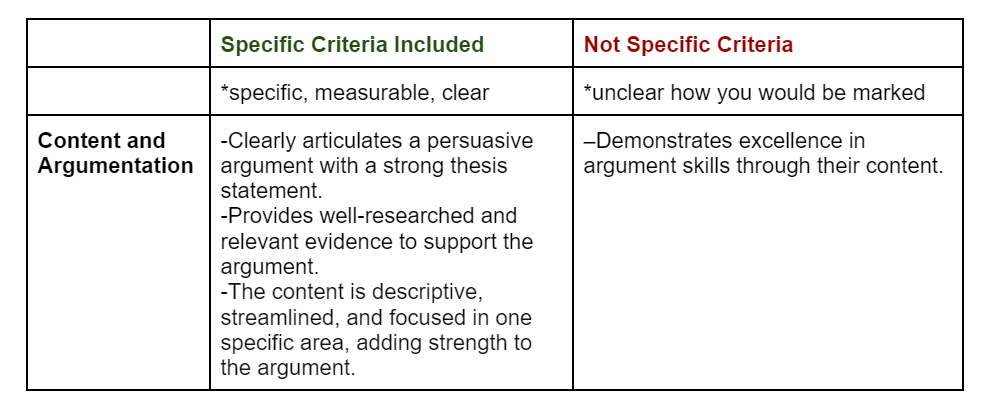
Rubrics
Rubrics offer multifaceted benefits that enhance both student learning and program improvement. They provide clarity regarding learning targets, enabling students to better understand and meet expectations. This clarity extends to instructional design, guiding educators in selecting appropriate approaches and environments to facilitate student achievement. Rubrics also promote fairness and accuracy in assessment by standardizing the evaluation process, resulting in consistent judgments across multiple raters. Additionally, they empower students with tools for self-assessment and peer feedback, fostering the development of critical evaluation skills and promoting collaborative learning environments. Importantly, rubrics have the potential to address disparities in learning expectations, making implicit assumptions explicit and accommodating diverse student backgrounds and experiences (Wolf K., & Stevens E., 2007).
Read More:
Checklists
Checklists offer a straightforward way for students to track their progress and ensure they meet all assignment requirements. They break down tasks into manageable steps, reducing the chances of missing crucial components. Checklists also help students prioritize their work, manage time effectively, and reduce anxiety by providing a clear path to completion. Instructors can use checklists to highlight key points, ensure alignment with learning objectives, and facilitate a structured approach to completing assignments.
Downloadable Resources:
Examples and Exemplars
Examples and exemplars provide concrete references for students to understand the quality and scope of work expected. They help demystify assignment requirements by showcasing high-quality submissions, demonstrating various ways to approach the task, and highlighting common pitfalls to avoid. Exemplars can serve as benchmarks for self-assessment, allowing students to compare their work against a standard and identify areas for improvement. By analyzing exemplars, students can gain insights into successful strategies and techniques, enhancing their own performance.
Scaffolded Support
Scaffolded support involves breaking down assignments into smaller, more manageable tasks, each building on the previous one. This approach helps students develop their skills progressively, providing necessary support at each stage. Scaffolding can include providing initial examples, guiding questions, incremental deadlines, and feedback opportunities. It enables students to tackle complex assignments with confidence, as they have a clear structure and continuous guidance. Scaffolded support ensures that students build a strong foundation, gradually increasing their independence and competence in handling assignments.
Opportunity for Feedback
Peer Review
Peer review involves students evaluating each other’s work, providing constructive feedback and gaining new perspectives. This process helps students develop critical thinking and analytical skills while fostering a collaborative learning environment. By engaging in peer review, students learn to give and receive feedback, refine their work based on peers’ suggestions, and improve their understanding of assignment criteria and expectations.
Feedback Opportunities
Regular feedback opportunities from instructors are essential for student growth and success. These can include formative feedback sessions, where instructors provide insights during the learning process, and summative feedback, which focuses on final evaluations. Prompt and specific feedback helps students identify strengths and areas for improvement, guiding them to adjust their learning strategies and achieve better outcomes. Utilizing tools like discussion boards, one-on-one meetings, and digital annotations can enhance the feedback process.
Implementing Digital Tools
ALDA
ALDA (AI Learning Design Assistant) is a web-based tool developed by the University of Saskatchewan to support educators in course design by leveraging AI technologies. Powered by GPT-4, ALDA helps educators create comprehensive course materials with a focus on inclusivity, accessibility, and alignment with institutional goals on diversity and ethical use of technology.
ALDA acts as a “thinking partner,” providing guidance on creating learning outcomes, rubrics, assessments, and course activities. It integrates University of Saskatchewan’s priorities by embedding principles of Equity, Diversity, Inclusion, and Accessibility (EDIA) in all its outputs. This makes ALDA particularly effective for ensuring that course content considers underrepresented groups and promotes inclusive, ethical teaching practices.
Some key features of ALDA include:
- Inclusive Course Development: ALDA assists educators in incorporating EDIA principles throughout course design, ensuring equitable representation and accessibility for all students.
- Rubric Redesigns and Learning Outcomes: ALDA helps develop rubrics that reflect EDIA awareness and align assessments with course objectives, ensuring that learning outcomes are met effectively.
- Generative Content Creation: Using AI capabilities, ALDA generates course descriptions, assessments, and activities tailored to the educator’s needs. Educators can further refine the generated content to fit their specific requirements.
- Flexibility and Adaptability: ALDA supports accessible teaching practices, enabling the creation of materials that meet the diverse needs of students, particularly those with varied learning preferences or accessibility needs.
ALDA adheres to academic integrity policies by ensuring that user inputs and outputs are not stored or used to train AI models. Educators retain full intellectual property rights over their content, and no data is saved between sessions. This reinforces ALDA’s commitment to responsible and ethical use of AI in education.
ALDA is freely available, using an USask NSID login:
Leveraging Canvas for Efficient Assessment Administration
Quizzes
New Quizzes within Canvas can serve as assessments designed to challenge student comprehension and evaluate their understanding of course content. Utilizing the quiz tool, instructors can create and administer online quizzes, facilitating various types of formative and summative assessments. When designing formative assessments or practice quizzes for learning purposes it is important to check off the box stating Do not count this assignment towards the final grade. This will ensure that the assessment does not affect the student’s grade, yet students will be able to see how they performed in their grades. Graded quizzes, which reward points based on correct responses, can be used as summative assessments, and displayed for students in their grades section. These grades will count towards students’ final grade in your course.
Additional Resources:
Discussions
A frequently used and impactful feature in many online or hybrid courses is the discussion forum. Discussions function as virtual group chats, facilitating the exchange of ideas and mutual assistance in understanding course topics. They serve as platforms for participants to collectively explore concepts, pose inquiries, and gain insights from one another’s perspectives. Discussions can also be used for assessment within your class.
You can add your rubric for the Discussion assessment through an attachment. This then provides students a downloadable file for them to reference and have a clear understanding of your expectations for the assessment.

When in Discussions you can create an assessment by selecting Graded. This will then give you the option to assign points possible and display the grade in the format you choose.
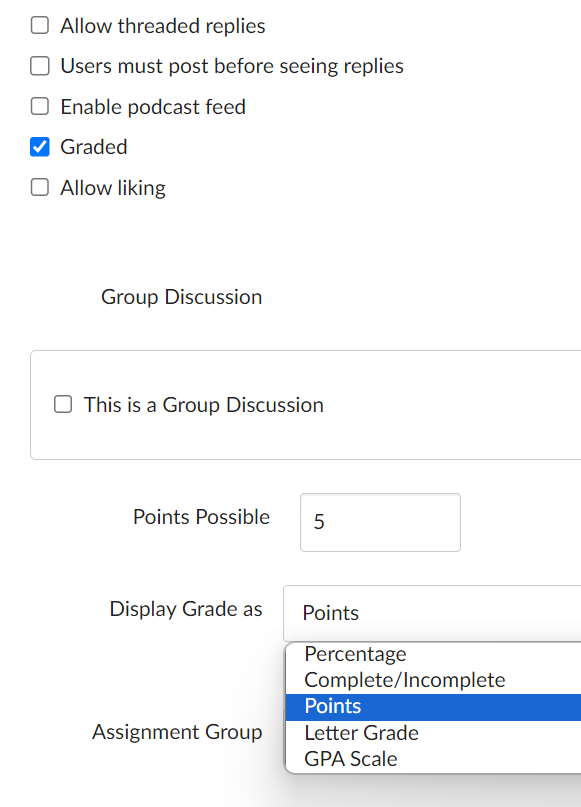
You are then able to assign the Discussion assessment to the students in your course and provide due and availability dates for students.
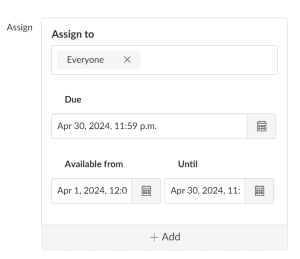
Assignments
The Assignments tool within Canvas serves as a platform for students to submit evidence of their learning, ranging from written reports to essays and slideshows. Canvas’s Assignments offers diverse submission options, allowing students to submit their work online through file uploads, images, text entries, URLs, and more.
The features within Assignments are designed to offer flexibility for both instructors and students, catering to diverse learning styles and preferences.
Once an assignment has been created in Canvas, you will need to develop a rubric that aligns with it to assess learners’ mastery of outcomes effectively. This can be achieved by attaching a pre-made rubric or creating one directly within Canvas.
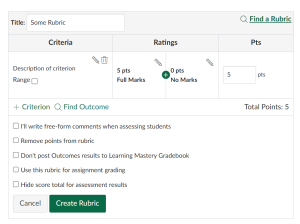
Attaching a pre-made rubric allows instructors to use an existing evaluation framework that aligns closely with the assignment’s outcomes. These rubrics can be sourced from various educational resources, such as ALDA, or developed by the instructor based on specific learning outcomes.
Alternatively, instructors can create a custom rubric within Canvas tailored to the assignment’s requirements and aligned with desired learning outcomes. Canvas provides tools for building rubrics with customizable criteria and performance levels, ensuring alignment with the assignment’s expectations.
This chapter highlights the importance of aligning outcomes with assessments and explores various tools and approaches to achieve this. By ensuring assessments reflect learning outcomes, educators provide clear expectations and insights into student progress, fostering consistency and relevance in evaluation practices. Utilizing resources like rubrics and tools such as ALDA, educators can refine assessment practices to promote equity and enhance the learning experience. Through alignment and effective utilization of assessment strategies, educators play a central role in facilitating student success in online education.
References:
altLAB. (2022). Creating good, valid, and reliable assessments. AltLAB. https://altlab.aut.ac.nz/guidance-for-teaching/creating-good-valid-and-reliable-assessments
Ashford-Rowe, K., Herrington, J., & Brown, C. (2014). Establishing the critical elements that determine authentic assessment. Assessment & Evaluation in Higher Education, 39(2), 205–222. https://doi.org/10.1080/02602938.2013.819566
Baker, E., Chung, G., & Cai, L. (2016). Assessment, gaze, refraction, and blur: The course of achievement testing in the past 100 years. Review of Research in Education, 40, 94–142. https://doi.org/10.3102/0091732X16679806
Beebe, R., Vonderwell, S., & Boboc, M. (2010). Emerging patterns in transferring assessment practices from f2f to online environments. Electronic Journal of e-Learning, 8(1), 1-12.
Biggs, J. (2014). Constructive alignment in university teaching. HERDSA Review of Higher Education, 1, 5–6. ISBN2652-6328
Biggs, J., & Tang, C. (2011). Teaching for quality learning at university. McGraw-hill education (UK).
Bowen, R. S. (2017). Understanding by Design. Vanderbilt University Center for Teaching. Retrieved [todaysdate] from https://cft.vanderbilt.edu/understanding-by-design/.
Chakrabartty, S. N. (2013). Best Split-Half and Maximum Reliability. IOSR Journal of Research & Method in Education, 3(1), 1-8.
Fuentealba, C. (2011). The role of assessment in the Student Learning Process. Journal of Veterinary Medical Education, 38(2), 157–162. https://doi.org/10.3138/jvme.38.2.157
Hung, M.L., Chou, C., Chen, C.H., & Own, Z.Y. (2010). Learner readiness for online learning: Scale development and student perceptions. Computers & Education, 55(3), 1080-1090. doi.org/10.1016/j.compedu.2010.05.004
Kebritchi, M., Lipschuetz, A., & Santiague, L. (2017). Issues and challenges for teaching successful online courses in higher education: A literature review. Journal of Educational Technology Systems, 46(1). doi.org/10.1177%2F0047239516661713
Lei, S.A., & Gupta, R.K. (2010) College distance education courses: evaluating benefits and costs from institutional, faculty and students’ perspectives. Education, 130(4), 616-631.
Rolim, C., & Isaias, P. (2018). Examining the use of e-assessment in higher education: teachers and students’ viewpoints. British Journal of Educational Technology, 50(4), 1785-1800. doi.org/10.1111/bjet.12669
Vlachopoulos, D. (2016). Assuring quality in e-learning course design: The roadmap. International Review of Research in Open and Distributed Learning, 17(6). doi.org/10.19173/irrodl.v17i6.2784
Weleschuk, A., Dyjur, P., & Kelly, P. (2019). Online Assessment in Higher Education. Taylor Institute for Teaching and Learning Guide Series. Calgary, AB: Taylor Institute for Teaching and Learning at the University of Calgary. Retrieved from https://taylorinstitute.ucalgary.ca/resources/guides
